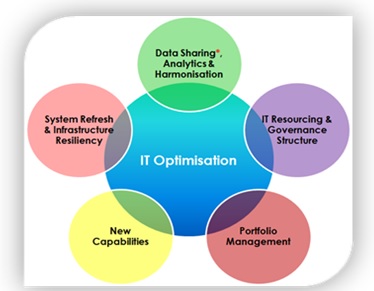NUS-ISS teams up with Singapore's Energy Market Authority to harness the power of strategic IT planning for a high-performance, knowledge-based public organisation.
Technological developments in recent decades have had profound impact on service delivery and the way organisations conduct business. It has enabled companies to connect with stakeholders more rapidly and from almost any corner in the world, paving the way towards increased productivity and collaboration.
At the same time, the shifting IT landscape gives organisations a compelling reason to evaluate their digital strategies regularly. It forces many to comtemplate the technologies, skills and best business practices that are relevant and critical for long-term growth and success.
Singapore's Energy Market Authority (EMA) was no exception. The Energy Market Authority (EMA) is a statutory board under the Ministry of Trade and Industry (MTI). Energy, a core resource for any country, represents the lifeblood of modern economies. As a regulator, power systems operator and industry developer , EMA plays a pivotal role in shaping Singapore's energy sector, promoting market competitiveness and ensuring a reliable and secure energy supply.
Taking the leap
Recognising the power of IT in its mission to forge a progressive energy landscape, EMA initiated a review of its IT priorities and investments in 2013 in support of its business strategies over the next three to five years. The aim was to address recent advances in technological capability, changing expectations on the use of IT, and to strengthen IT leadership, governance, management and capability.
EMA proceeded to work with NUS-ISS under a joint collaborative model - one that would allow both EMA and NUS-ISS to mutually utilise their respective capabilities, resources and market access in the development of EMA's Strategic IT Plan.
"By partnering with NUS-ISS, EMA was able to formulate a deliberate and systematic approach in evaluating IT's contribution to business while tapping into NUS-ISS' Strategic IT Master Planning Methodology," said Dr Kang Cheng Guan, CIO, EMA.
Tried and true
The proven methodology involves technology scanning, interviews with key executives, examination of documents and reports, and an assessment of IT resources. A customised communication plan was also developed to serve as a roadmap for the project team, project sponsor, and other project stakeholders.
Conducted in five stages over a nine-month period, the review exercise was initiated by EMA to focus on five main thrusts: System Refresh and Infrastructure Resiliency; IT Resourcing & Governance Structure; Portfolio Management; Data Sharing, Analytics and Harmonisation; and New Capabilities. with the overall aim to achieve IT optimisation.

The five main thrusts
In good hands
Together with experienced NUS-ISS consultants, the team articulated EMA's business potential, worked out the operational gaps in the IT environment, and put together a clear and achievable Strategic IT Plan aligned to EMA's business requirements.
"The NUS-ISS team comprised experienced consultants who had previously worked as CIOs, or equivalent, in both the government and private sectors. They are knowledgeable and appreciative of the challenges and issues we faced," said Mr Don Wee, Deputy Director (Business IT), EMA.
Getting the right insights
According to NUS-ISS Lead Consultant and Member of the IT Strategy and Management Practice, Ms Tan Lay Ngan, an effective Strategic IT Plan should enable organisations to create proper alignment between IT and business objectives. It entails applying the right techniques and selecting the right IT opportunities in achieving the organisation's mission.
"A well-defined Strategic IT Plan is a management tool that all C-level executives should master and establish - especially those who are serious about using IT to enable growth," Lay Ngan said. Like EMA, companies who are seeking to implement or refresh their Strategic IT Plans can start by building on existing IT systems, applications and expertise to maximise mission accomplishment, she added.
Other useful and relevant considerations include adopting a unified and coherent approach to setting project priorities and investment decisions, and taking a longer-term view of the risks and returns on IT investments - beyond the merits of standalone projects.
"Over time, companies, including EMA, should expect to see their operations and processes becoming more streamlined, standardised and integrated. This would drive their businesses in a more resource-efficient and cost-effective way," concluded Lay Ngan.
|
The Five-Point Advantage in NUS-ISS' Strategic IT Planning Consulting Service:
- Provide consultancy in the implementation of Strategic IT Plans
- Conduct training to build competency within the organisation
- Provide mentorship on Strategic IT Planning
- Translate knowledge, skills and best practices into impactful business results
- Equip organisations to operate independently upon project completion
|
NUS-ISS has provided consultancy to numerous ministries and statutory boards, academic institutions, as well as financial organisations in the area of Strategic IT Planning. It also facilitates workshops to help organisations identify their business goals, strategies and IT directions.
Gain insights to potential IT applications, develop a customised IT architecture blueprint, and draw up implementation plans complete with overviews in IT organisational structure and financial analysis. To find out how NUS-ISS can help your organisation, please contact Theresa at isstvc@nus.edu.sg or +65 6516 5311.